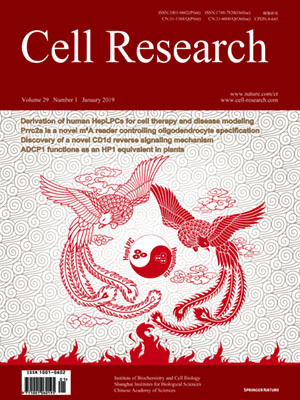
Volume 29, No 1, Jan 2019
ISSN: 1001-0602
EISSN: 1748-7838 2018
impact factor 17.848*
(Clarivate Analytics, 2019)
Volume 29 Issue 1, January 2019: 54-66 | Open Access
ORIGINAL ARTICLES
Plant HP1 protein ADCP1 links multivalent H3K9 methylation readout to heterochromatin formation
Shuai Zhao 1,2, Lingling Cheng 1, Yifei Gao 1, Baichao Zhang 1,2, Xiangdong Zheng 1,2, Liang Wang 1, Pilong Li 1, Qianwen Sun 1 and Haitao Li 1,2
1MOE Key Laboratory of Protein Sciences, Beijing Advanced Innovation Center for Structural Biology, Tsinghua-Peking Joint Center for Life Sciences, School of Life Sciences, Tsinghua University, Beijing 100084, China and 2Department of Basic Medical Sciences, School of Medicine, Tsinghua University, Beijing 100084, China
Correspondence: Pilong Li (plli_lab@biomed.tsinghua.edu.cn) or Qianwen Sun (sunqianwen@tsinghua.edu.cn) or Haitao Li (lht@tsinghua.edu.cn)These authors contributed equally: Shuai Zhao, Lingling Cheng, Yifei Gao, Baichao Zhang
Heterochromatin Protein 1 (HP1) recognizes histone H3 lysine 9 methylation (H3K9me) through its conserved chromodomain and maintains heterochromatin from fission yeast to mammals. However, in Arabidopsis, Like Heterochromatin Protein 1 (LHP1) recognizes and colocalizes genome-wide with H3K27me3, and is the functional homolog of Polycomb protein. This raises the question whether genuine HP1 homologs exist in plants. Here, we report on the discovery of ADCP1, a plant-specific triple tandem Agenet protein, as a multivalent H3K9me reader in Arabidopsis, and establish that ADCP1 is essential for heterochromatin formation and transposon silencing through modulating H3K9 and DNA methylation levels. Structural studies revealed the molecular basis underlying H3K9me-specific recognition by tandem Agenet of ADCP1. Similar to human HP1α and fly HP1a, ADCP1 mediates heterochromatin phase separation. Our results demonstrate that despite its distinct domain compositions, ADCP1 convergently evolves as an HP1-equivalent protein in plants to regulate heterochromatin formation.
https://doi.org/10.1038/s41422-018-0104-9
FULL TEXT | PDF
Browse 1312


